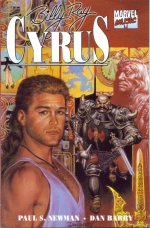
Black History Month ’09 #19: Bridging the Gap
February 19th, 2009 Posted by david brothersA book that I’m enjoying quite a bit is Joshua Dysart and Alberto Ponticelli’s Unknown Soldier from DC’s Vertigo imprint. I first found Dysart via Mike Mignola’s BPRD series, and Ponticelli’s entirely new to me. Together, the two of them have created one of the more interesting books to come out of DC Comics in more than a few years.
Previously, the Unknown Soldier was just that- an unknown soldier. Depending on the version, his identity was kept secret from the characters he interacted with or even the reader. He was often tied to World War II, but the new one is more closely associated with the war-torn land of Uganda.
It stars Dr. Moses Lwanga, a normal man and relief worker who has come to Uganda with his wife. He’s a good man, and a kind one, but this kindness backfires when he runs out of the camp to help someone and is ambushed by child soldiers of the Lord’s Resistance Army. A voice whispers in his ear and he knows exactly what he has to do in order to kill the children and save his life. He does it and is immediately overcome with despair. He destroys his face with a rock and lays down to bleed to death.
After a curious series of events, Moses has found himself in a situation where he is traveling under a false name and danger lurks around every corner. Eventually, push comes to shove and he has to listen to that little voice in his ear to survive, even if surviving means the death of multiple children by his own hand. Add in the trials of Moses’s wife, who does not know what happened to him or where he is, and you have a startling picture of modern-day Uganda.
Unknown Soldier, when it’s on, is a gripping comic. The end of the first issue is a pretty good depiction of despair and fear as any, and was what originally hooked me on the series. Dysart has clearly done his homework, as both the work and his supplemental material shows. Ponticelli’s art isn’t realistic in a Bryan Hitch kind of way, but still does a great job of getting across exactly what it needs to. The violence is ugly, wounds look painful, and damage goes further than “ripped shirt, scuffed cheeks, bloody nose.” When Moses destroys his face, there’s a panel where the rock catches on his lips. “Beautiful” is the wrong word for it, but it’s a little touch like that that sells the book.
I think that if Unknown Soldier keeps up, and the quality stays high, it could be one of those classic Vertigo books that really captures people’s hearts. It’s not high fantasy for dreary goths, and it isn’t an irreverent spin on American culture. It’s just the story of a man who is up against a wall, knows exactly what to do to escape, but finds the solution so reprehensible that he can barely stand to do it.



